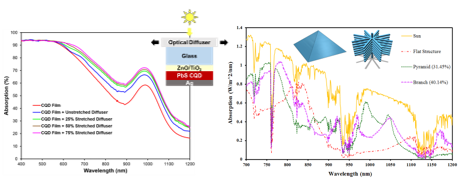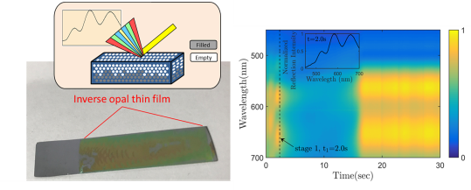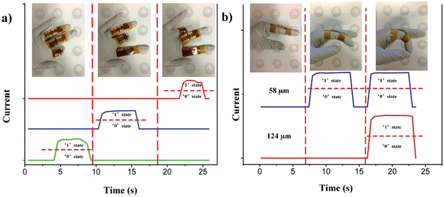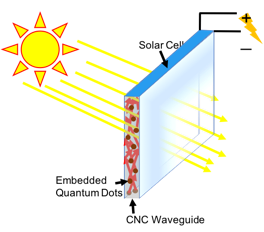The group's research is centered in the general areas of solid-state electronics and photonics with particular attention to apply nanomaterials
and micro-/nanofabrication for next-generation electronic, photonic, and optoelectronic devices. The research projects include design, fabrication,
and characterization of colloidal quantum dot (CQD) and cellulose nanocrystal (CNC) based electronic and photonic devices,
as well as micro-/nanostructured devices for sensing and energy harvesting.
Colloidal quantum dot (CQD) optoelectronics

[1] S. Mahpeykar, Q. Xiong & X. Wang, "Resonance-induced absorption enhancement in colloidal quantum dot solar cells using nanostructured electrodes", Optics Express 22, A1576 (2014).
[2] S. Mahpeykar, Q. Xiong, J. Wei, L. Meng, B. K. Russell, P. Hermansen, A. V. Singhal & X. Wang, "Stretchable hexagonal diffraction gratings as optical diffusers for in-situ tunable broadband photon management", Advanced Optical Materials 4, 1106 (2016).
[3] A. Kiani, H. F. Movahed, S. Hoogland, O. Voznyy, R. Wolowiec, L. Levina, F. P. Garcia de Arguer, P. Pietsch, X. Wang, P. Maraghechi & E. H. Sargent, "Gradient-doped colloidal quantum dot slids enable thermophotovoltaic harvesting of waster heat", ACS Energy Letters 1, 740 (2016).
[4] L. Meng, Q. Xu, S. Fan, C. Dick & X. Wang, "Field-effect enhanced triboelectric colloidal quantum dot flexible sensor", Applied Physics Letters 111, 183103 (2017).
[5] Q. Xiong, F. I. Chowhury & X. Wang, "Filter-free narrowband photodetectors employing colloidal quantum dots", IEEE Journal of Selected Topics in Quantum Electronics 24, 1900406 (2018).
[6] Q. Xu, L. Meng, T. Zeng, K. Sinha, C. Dick & X. Wang, "On-chip colloidal quantum dot devices with a CMOS compatible architecture for near-infrared light sensing", Optics Letters 44, 463 (2019).
[7] Q. Xu, L. Meng, K. Sinha, F. I. Chowdhury, J. Hu & X. Wang, "Ultrafast colloidal quantum dot infrared photodiode", ACS Photonics 7, 1297 (2020).
Micro-/nanophotonics

[1] Q. Xiong, J. Wei, S. Mahpeykar, L. Meng & X. Wang, "Observation of localized surface plasmons and hybridized surface plasmon polaritons on self-assembled two-dimentional nanocavities", Optics Letters 41, 1506 (2016).
[2] Q. Xu, L. Meng & X. Wang, "Nanocrystal-filled polymer for improving angular color uniformity of phosphor-converted white LEDs", Applied Optics 58, 7649 (2019).
[3] Q. Xu, S. Mahpeykar, I. B. Burgess & X. Wang, "Inverse opal photonic crystals as an optofluidic platform for fast analysis of hydrocarbon mixtures", ACS Applied Materials & Interfaces 10, 20120 (2018).
[4] B. Dyett, Q. Zhang, Q. Xu, X. Wang & X. Zhang, "Extraordinary focusing effect of surface nanolenses in total internal reflection mode", ACS Central Science 4, 1511 (2018).
[5] L. Bao, B. Pinchasik, L. Lei, Q. Xu, H. Hao, X. Wang & X. Zhang, "Controlling of femtoliter liquid on a microlens: a way to flexible dual microlens arrays", ACS Applied Materials & Interfaces 11, 27386 (2019).
Flexible electronics

[1] L. Meng, S. Fan, S. Mahpeykar & X. Wang, "Digital microelectromechanical sensor with an engineered polydimethylsiloxane (PDMS) bridge structure", Nanoscale 9, 1257 (2017).
[2] S. Fan, L. Dan, L. Meng, W. Zheng, A. Elias & X. Wang, “Improved response time of flexible microelectromechanical sensors employing eco-friendly nanomaterials”, Nanoscale 9, 16915 (2017).
[3] S. Fan, L. Meng, L. Dan, W. Zheng & X. Wang, "Polymer microelectromechanical system-integrated flexible sensors for wearable technologies", IEEE Sensors Journal 19, 443 (2019).
[4] L. Meng, Q. Xu, L. Dan & X. Wang, "Single-walled carbon nanotube based triboelectric flexible touch sensors", IEEE/TMS Journal of Electronic Materials 48, 7411 (2019).
Eco-friendly materials for electronics and optoelectronics

[1] L. Meng, S. Mahpeykar, Q. Xiong, B. Ahvaz & X. Wang, "Strain sensors on water-soluble cellulose nanofibril paper by polydimethylsiloxane (PDMS) stencil lithography", RSC Advances 6, 85427 (2016).
[2] F. I. Chowdhury, C. Dick, L. Meng, S. Mahpeykar, B. Ahvazi & X. Wang, "Cellulose nanocrystals as host matrix and waveguide materials for recyclable luminescent solar concentrators", RSC Advances 7, 32436 (2017).
[3] S. Mahpeykar, Y. Zhao, X. Li, Z. Yang, Q. Xu, Z-H. Lu, E. H. Sargent & X. Wang, "Cellulose nanocrystal:polymer hybrid optical diffusers for index-matching-free light management in optoelectronic devices", Advanced Optical Materials 5, 1700430 (2017).
[4] Q. Xu, L. Meng & X. Wang, "Reducing shadowing losses in silicon solar cells using cellulose nanocrystal:polymer hybrid diffusers", Applied Optics 58, 2505 (2019).